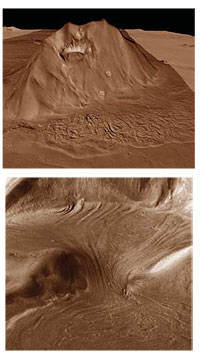 |
Office of Media Relations | |||
News | ||||
|
Martian Snow Source of Tropical Glaciers, Research Team Reports
Recent images beamed from Mars reveal intriguing evidence of glacial deposits in the tropics of the Red Planet. But how did this Martian ice form so far from the poles? Ancient snows, according to new research appearing in Science. PROVIDENCE, R.I. — Snow is the source of glacial deposits found at the base of the majestic volcanoes and mountains dotting the mid-latitude and tropical regions of Mars. Based on an innovative blend of geological observations and climate modeling created by a team of American and French scientists, the finding appears in Science. Discovery of the source of the tropical glaciers ends a 30-year Martian mystery. In 1976, cameras aboard NASA’s Viking Mission to Mars captured unprecedented views of the canyons and craters of the Red Planet – including polar ice caps. Recent spacecraft data reveal curious rock-strewn deposits found at the foot of volcanoes and mountains close to the equator.  Stormy weather In the last two years, Brown University planetary geologist James Head and other Mars experts have offered up mounting evidence that these ice-rich landforms – which appear to ooze out of valleys in the Eastern Hellas region or puddle on the western flanks of the three giant volcanoes known as the Tharsis Montes – are the remnants of geologically recent glaciers. But how could ice form so far from the planet’s poles? Long-ago landslides? Upwelling from an underground reservoir? “What we found,” Head said, “was that the glaciers were formed from snow brought from the polar regions.” A few million years ago, Head and the team explain, the axis of Mars was tilted in such a way that the poles were pointing dramatically closer to the sun. Sun rays hit the polar ice caps nearly head on, releasing massive amounts of water vapor into the atmosphere. Monsoon-like winds carried the water vapor south, up and over the soaring slopes of the Tharsis Montes volcanoes and Olympus Mons, the solar system’s largest volcano. The vapor cooled, condensed and fell in the form of snow. Over time, the snow turned to ice, the ice formed glaciers, and the glaciers created the deposits seen today. The Martian precipitation cycle described in Science is similar to the one on Earth that routinely blankets mountainous regions such as the Rockies in snow. Another Earthly analog: the tropical mountain glaciers described in the article can be found in places such as Mount Kilimanjaro in Africa or the Andean peaks in South America. The team arrived at their finding using a climate model that simulated the present-day Mars water cycle but assumed a 45-degree axial tilt found on the planet millions of years ago. The model created a near-perfect match of predicted ice accumulation and direct observational evidence from images taken by the Mars Express, Mars Global Surveyor and Mars Odyssey orbiters. “The findings are important because they tell us that Mars has experienced big climate changes in the past, the kinds of climate change that led to the Great Ice Age here on Earth,” said Head, the Louis and Elizabeth Scherck Distinguished Professor at Brown. “The findings are also interesting because this precipitation pattern may have left pockets of ice scattered across Mars. This is good information for NASA as officials plan future space missions, particularly with astronauts.” The team also includes scientists from the Institut Pierre Simon Laplace and the Institut de Mecanique in Paris as well as the NASA Ames Research Center. The Centre National de la Recherche Scientifique, the European Space Agency and NASA funded the work. ###### Media Relations Home | Top of File | e-Subscribe | Brown Home Page | ||||